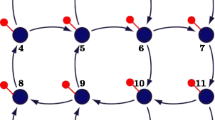Abstract
Photonic-based reservoir computing (RC) systems have attracted significant attention. Integrated and purely passive systems are compatible with complementary metal-oxide-semiconductor devices, but are limited by the lack of non-linear components. This study consists of two parts: firstly, a review on the published integrated and passive RC system is presented. The review focuses on the structural configuration (rather than the mathematical model) of the neural network; secondly, a new approach for achieving an integrated and passive photonic RC system is introduced and discussed. This approach employs a mode combiner in front of the reservoir to achieve an extra non-linearity in a purely passive device. Moreover, the approach is numerically investigated, and an XOR (exclusive or) task is used to test the device, and the result shows that the new approach satisfies the requirement of an RC system.
Similar content being viewed by others
References
Jaeger H. Harnessing nonlinearity: predicting chaotic systems and saving energy in wireless communication. Science, 2004, 304: 78–80
Maass W, Natschläger T, Markram H. Real-time computing without stable states: a new framework for neural computation based on perturbations. Neural Comput, 2002, 14: 2531–2560
Tanaka G, Yamane T, Héroux J B, et al. Recent advances in physical reservoir computing: a review. Neural Netw, 2019, 115: 100–123
Vandoorne K, Mechet P, van Vaerenbergh T, et al. Experimental demonstration of reservoir computing on a silicon photonics chip. Nat Commun, 2014, 5: 3541
Katumba A, Freiberger M, Bienstman P, et al. A multiple-input strategy to efficient integrated photonic reservoir computing. Cogn Comput, 2017, 9: 307–314
Freiberger M, Katumba A, Bienstman P, et al. On-chip passive photonic reservoir computing with integrated optical readout. In: Proceedings of 2017 IEEE International Conference on Rebooting Computing (ICRC), 2017. 1–4
Katumba A, Heyvaert J, Schneider B, et al. Low-loss photonic reservoir computing with multimode photonic integrated circuits. Sci Rep, 2018, 8: 2653
Fiers M A A, van Vaerenbergh T, Wyffels F, et al. Nanophotonic reservoir computing with photonic crystal cavities to generate periodic patterns. IEEE Trans Neural Netw Learn Syst, 2014, 25: 344–355
Laporte F, Katumba A, Dambre J, et al. Numerical demonstration of neuromorphic computing with photonic crystal cavities. Opt Express, 2018, 26: 7955
van Vaerenbergh T, Fiers M, Dambre J, et al. Efficient simulation of optical nonlinear cavity circuits. Opt Quant Electron, 2015, 47: 1471–1476
Schneider B, Dambre J, Bienstman P. Using digital masks to enhance the bandwidth tolerance and improve the performance of on-chip reservoir computing systems. IEEE Trans Neural Netw Learn Syst, 2016, 27: 2748–2753
Katumba A, Freiberger M, Laporte F, et al. Neuromorphic computing based on silicon photonics and reservoir computing. IEEE J Sel Top Quantum Electron, 2018, 24: 1–10
Ma C, Sackesyn S, Dambre J, et al. All-optical readout for integrated photonic reservoir computing. In: Proceedings of 2019 21st International Conference on Transparent Optical Networks (ICTON), 2019. 1–4
Zhang H, Feng X, Li B, et al. Integrated photonic reservoir computing based on hierarchical time-multiplexing structure. Opt Express, 2014, 22: 31356
Acknowledgements
This work was supported by National Science Foundation (Grant No. NSF-1710885).
Author information
Authors and Affiliations
Corresponding author
Rights and permissions
About this article
Cite this article
Wu, D., Yi, Y. & Zhang, Y. A brief review of integrated and passive photonic reservoir computing systems and an approach for achieving extra non-linearity in passive devices. Sci. China Inf. Sci. 63, 160402 (2020). https://doi.org/10.1007/s11432-019-2837-0
Received:
Revised:
Accepted:
Published:
DOI: https://doi.org/10.1007/s11432-019-2837-0




